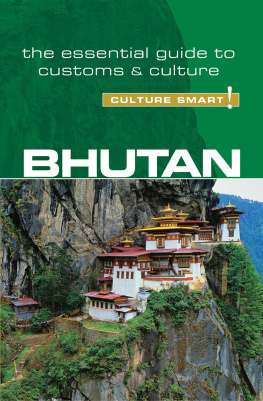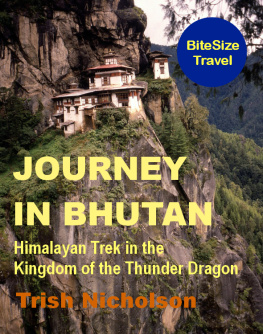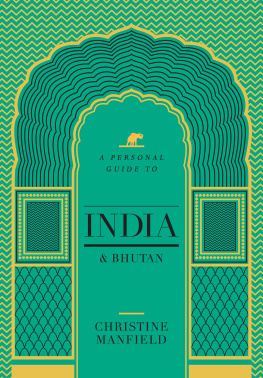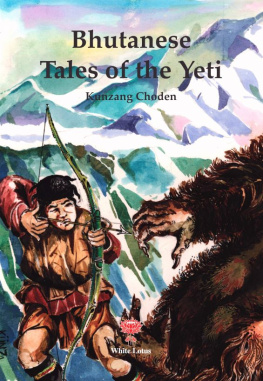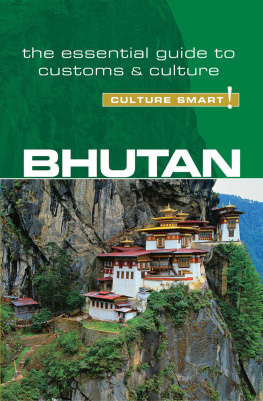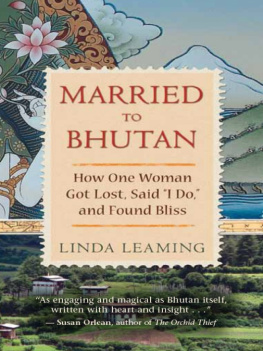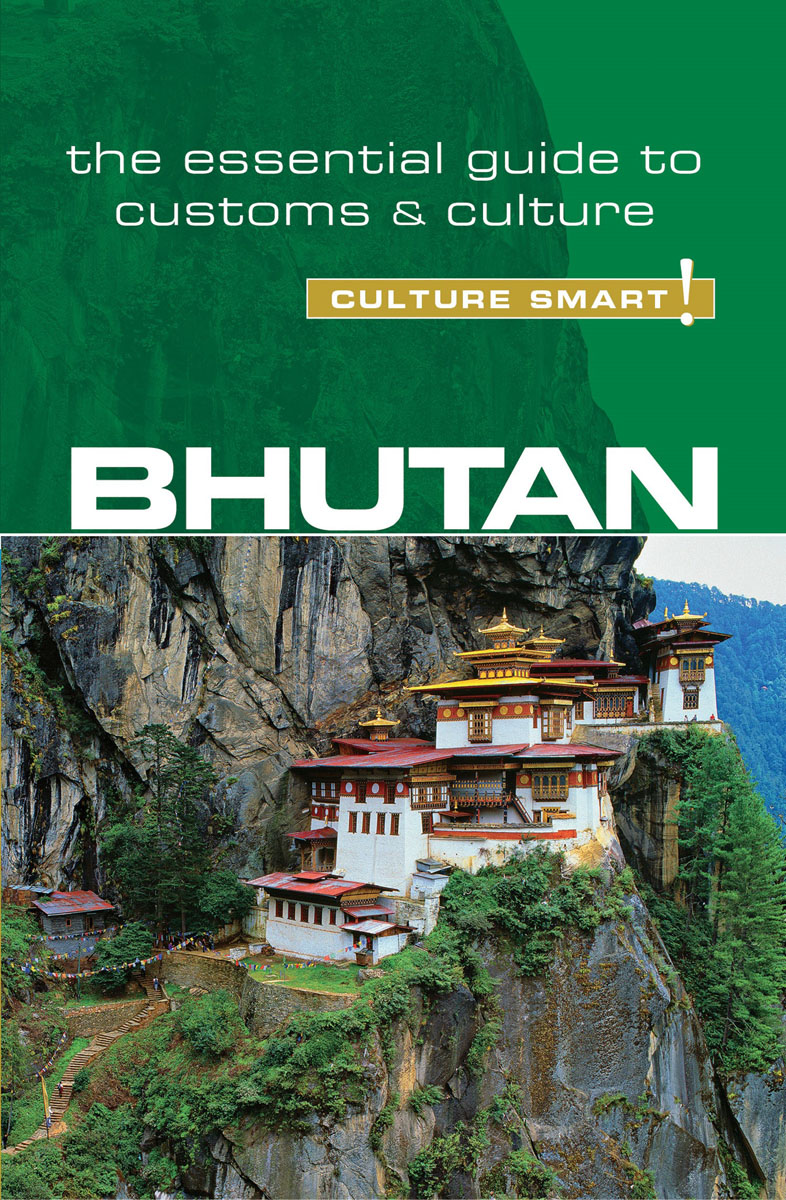
This book is available for special discounts for bulk purchases for sales promotions or premiums. Special editions, including personalized covers, excerpts of existing books, and corporate imprints, can be created in large quantities for special needs.
For more information contact Kuperard publishers at the address below.
ISBN 978 1 85733 875 1
British Library Cataloguing in Publication Data
A CIP catalogue entry for this book is available from the British Library
First published in Great Britain
by Kuperard, an imprint of Bravo Ltd
59 Hutton Grove, London N12 8DS
Tel: +44 (0) 20 8446 2440 Fax: +44 (0) 20 8446 2441
www.culturesmart.co.uk
Inquiries:
Series Editor Geoffrey Chesler
Design Bobby Birchall
Printed in Malaysia
Cover image: Taktsang Monastery, known as The Tigers Nest, in Paro province, Bhutan. Shutterstock.
The photographs on pages (top) are reproduced by permission of the author.
Image on Shutterstock.com.
Images on the following pages reproduced under Creative Commons Attribution-Share Alike 4.0 International license: (top) Ominae.
Reproduced under Creative Commons Attribution-Share Alike 3.0 Unported license: (bottom) Sunkissedguy.
Creative Commons Attribution-Share Alike 2.5 Generic license: L. Shyamal.
Creative Commons Attribution-Share Alike 2.0 Generic license: stull 17.
About the Author
KARMA CHODEN is the founder of Simply Bhutan Travels, and a freelance writer. She has a degree in English Literature from the University of North Bengal, India, worked as a journalist for many years with Kuensel, Bhutans national newspaper, and served as a commissioner and focal person for the National Commission for Women and Children in Bhutan.
DORJI WANGCHUK is a management consultant working in London. He has a degree in engineering from the National Institute of Technology in Calicut, India, and an MBA from the University of Cambridge. He was a civil servant in the Bhutanese government for many years, and gives regular talks on developments in Bhutan.
The Culture Smart! series is continuing to expand. All Culture Smart! guides are available as e-books, and many as audio books.
For latest titles visit
www.culturesmart.co.uk
The publishers would like to thank CultureSmart!Consulting for its help in researching and developing the concept for this series.
CultureSmart!Consulting creates tailor-made seminars and consultancy programs to meet a wide range of corporate, public-sector, and individual needs. Whether delivering courses on multicultural team building in the USA, preparing Chinese engineers for a posting in Europe, training call-center staff in India, or raising the awareness of police forces to the needs of diverse ethnic communities, it provides essential, practical, and powerful skills worldwide to an increasingly international workforce.
For details, visit www.culturesmartconsulting.com
CultureSmart!Consulting and CultureSmart! guides have both contributed to and featured regularly in the weekly travel program Fast Track on BBC World TV.
contents
Map of Bhutan

introduction
Until recently many people had never heard of Bhutan, and many of those who had knew little about it, probably thinking of it as a mystical, faraway land hidden in the folds of the Himalayasor the last Shangri-la, as it was often referred to by those adventurous few who made it to its valleys.
Today, however, Bhutan is becoming known all over the world for three things: for its pursuit of happiness as the goal of development; for Buddhism as its predominant way of life; and for its unspoiled natural environment. With more than 70 percent of the country under forest cover, and thanks to its continuous conservation efforts, Bhutan has emerged as the only carbon-negative country in the world.
The Bhutanese people consider themselves blessed both by great Buddhist masters and by the benevolence of the kings of the Wangchuck dynasty; as being rich in traditional culture and customs; and as having a sense of purpose in a world driven by globalization and material pursuits. Gross National Happiness (GNH)Bhutans unique philosophy of development that focuses on more than just conventional economic growth by giving equal priority to environmental conservation and cultural preservationchallenges the world to reconsider its ideas about progress and wellbeing.
As Bhutan has gradually emerged from its self-imposed isolation over the last fifty-plus years, it has been careful with its choices, and the process of modernization and development has been deliberately slow. Roads, hospitals, and schools have been built, but television and the Internet did not arrive until 1999. English has been embraced as the medium of instruction in schools, but children wear traditional costumes as their school uniform.
Bhutan has opened its doors to the world, but has restricted the inflow of visitors with a high-value, low-impact tourism policy, ensuring steady foreign exchange earnings while protecting its unique society from undue outside influence.
In 2008 Bhutan made a giant leap and became the worlds youngest democracy, giving way from absolute to constitutional monarchya historic change that came not through popular demand but directly from the throne, initiated by the fourth king, His Majesty Jigme Singye Wangchuck. Bhutan faces the issues of any emerging third-world country, such as rising debt and youth unemployment, but it is well positioned through its education and economic policies to manage the economy without significant distress.
Culture Smart! Bhutan aims to give the reader an insight into the countrys history, values, customs, and age-old traditions. It describes the historical circumstances that have shaped the Bhutanese people and their way of life. It debunks some myths and helps you to discover this fascinating country for yourself. It highlights changes in attitudes and behavior as the country modernizes, while offering guidance on how to develop a rapport with the Bhutanese and forge meaningful friendships and business opportunities.
Key Facts
Official Name | Kingdom of Bhutan | Locally known as Drukyul (Land of the Thunder Dragon) |
Capital City | Thimphu | Pop. of Thimphu city (est. 100,000) |
Major Towns | Phuentsholing, Gelephu, Paro, Mongar, Samdrupjongkhar |
Area | 14,826 square miles (38,400 sq. km) |
Climate | Alpine, temperate, and subtropical |
Currency | Bhutanese ngultrum (Nu.) (100 chetrum) | Pegged to and on a par with the Indian rupee. In July 2017 US $1 = Nu.64.78 |
Population | 768,577 (est. 2016) |
Life Expectancy | 70.11 for women; 69.57 for men (2015) |
GDP Per Capita | US $2,719 (2015) |
Literacy Rate | 63.0% (2012) |
Next page
